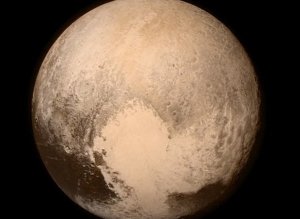Lost amide the daily political nonsense is a significant achievement, scientific and national:
New Horizons launched on Jan. 19, 2006; it swung past Jupiter for a gravity boost and scientific studies in February 2007. after almost ten years and over 3 billion miles, it will conduct a five-month-long reconnaissance flyby study of Pluto and its moons this summer. Pluto closest approach was scheduled for yesterday, July 14, 2015. As part of an extended mission, the spacecraft is expected to head farther into the Kuiper Belt to examine one or two of the ancient, icy mini-worlds in that vast region, at least a billion miles beyond Neptune’s orbit.
The Johns Hopkins University Applied Physics Laboratory (APL) in Laurel, Maryland, designed, built, and operates the New Horizons spacecraft and manages the mission for NASA’s Science Mission Directorate.
New Horizons seeks to understand where Pluto and its moons “fit in” with the other objects in the solar system, such as the inner rocky planets (Earth, Mars, Venus and Mercury) and the outer gas giants (Jupiter, Saturn, Uranus and Neptune).
Pluto and its largest moon, Charon, belong to a third category known as "ice dwarfs." They have solid surfaces but, unlike the terrestrial planets, a significant portion of their mass is icy material.
Using Hubble Space Telescope images, New Horizons team members have discovered four previously unknown moons of Pluto: Nix, Hydra, Styx and Kerberos.
The planets circle the Sun all in the same flat disc pattern, presumably coalescing from early gas clouds at the formation of the solar system. The Kuiper Belt is different; it sits on a different plane from the planetoid plane, as if disrupted from an early event or gravitational change. The Kuiper Belt could contain hundreds of thousands of icy bodies that range in size from small chunks of ice to worldlets larger than 100 kilometres across. Astronomers have tracked most short-period comets from their origins in the Kuiper Belt. These are comets with orbital periods of 200 years or less. There could be more than a trillion comet nuclei in the main body of the Kuiper Belt. The largest Kuiper Belt Objects are Pluto, Quaoar, Makemake, Haumea, Ixion, and Varuna.
Further out is the Oort Cloud, a cloud of particles theorized to be the remains of the disc of material that formed the Sun and planets. Astronomers now refer to those primeval objects as a protoplanetary disk. The most likely theory is that the material now in the Oort Cloud probably formed closer to the young Sun in the earliest epochs of solar system formation. As the planets grew, and in particular as Jupiter coalesced and migrated to its present position, its gravitational influence is thought to have scattered many icy objects out to their present position in the Oort cloud. The planetoid Sedna, discovered in 2003, is thought to be a member of the inner Oort Cloud. Long term comets may originate there.
Pluto:

New Horizons launched on Jan. 19, 2006; it swung past Jupiter for a gravity boost and scientific studies in February 2007. after almost ten years and over 3 billion miles, it will conduct a five-month-long reconnaissance flyby study of Pluto and its moons this summer. Pluto closest approach was scheduled for yesterday, July 14, 2015. As part of an extended mission, the spacecraft is expected to head farther into the Kuiper Belt to examine one or two of the ancient, icy mini-worlds in that vast region, at least a billion miles beyond Neptune’s orbit.
The Johns Hopkins University Applied Physics Laboratory (APL) in Laurel, Maryland, designed, built, and operates the New Horizons spacecraft and manages the mission for NASA’s Science Mission Directorate.
New Horizons seeks to understand where Pluto and its moons “fit in” with the other objects in the solar system, such as the inner rocky planets (Earth, Mars, Venus and Mercury) and the outer gas giants (Jupiter, Saturn, Uranus and Neptune).
Pluto and its largest moon, Charon, belong to a third category known as "ice dwarfs." They have solid surfaces but, unlike the terrestrial planets, a significant portion of their mass is icy material.
Using Hubble Space Telescope images, New Horizons team members have discovered four previously unknown moons of Pluto: Nix, Hydra, Styx and Kerberos.
The planets circle the Sun all in the same flat disc pattern, presumably coalescing from early gas clouds at the formation of the solar system. The Kuiper Belt is different; it sits on a different plane from the planetoid plane, as if disrupted from an early event or gravitational change. The Kuiper Belt could contain hundreds of thousands of icy bodies that range in size from small chunks of ice to worldlets larger than 100 kilometres across. Astronomers have tracked most short-period comets from their origins in the Kuiper Belt. These are comets with orbital periods of 200 years or less. There could be more than a trillion comet nuclei in the main body of the Kuiper Belt. The largest Kuiper Belt Objects are Pluto, Quaoar, Makemake, Haumea, Ixion, and Varuna.
Further out is the Oort Cloud, a cloud of particles theorized to be the remains of the disc of material that formed the Sun and planets. Astronomers now refer to those primeval objects as a protoplanetary disk. The most likely theory is that the material now in the Oort Cloud probably formed closer to the young Sun in the earliest epochs of solar system formation. As the planets grew, and in particular as Jupiter coalesced and migrated to its present position, its gravitational influence is thought to have scattered many icy objects out to their present position in the Oort cloud. The planetoid Sedna, discovered in 2003, is thought to be a member of the inner Oort Cloud. Long term comets may originate there.
Pluto:

No comments:
Post a Comment